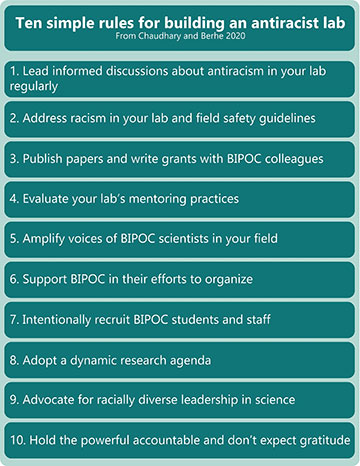![]()
Author Bala Chaudhary [Image: Jamie Moncrief]
Increasingly, the scientific community has begun to grapple with the lack of diversity in STEM, and to recognize the need for guidance on how to engage in antiracist action (see “In Search of Equity,” OPN, September 2020). Now, two researchers in the U.S., V. Bala Chaudhary at DePaul University and Asmeret Asefae Berhe at the University of California Merced, have outlined what they say are 10 concrete, actionable suggestions for developing an antiracist lab (PLOS Comput. Biol., doi: 10.1371/journal.pcbi.1008210).
Taking the lead
Chaudhary and Berhe, both environmental scientists and both women of color, met on Twitter, where they connected over their passion for diversity, equity and inclusion in STEM. In their editorial, the two researchers lay out 10 rules designed to give principal investigators (PIs) immediate and straightforward steps to build an equitable and inclusive lab. “It is our hope,” the authors write, “that partaking in such actions will help lead to improved racial and ethnic diversity and inclusion in the lab and successful scientific lives for all.”
The first step, says Chaudhary, is for the research group leader or PI to take responsibility for creating a supportive lab environment. “The role of the PI is to lead,” Chaudhary explained to OPN in an email. “We lead the lab in terms of research agenda, workplace culture, mentorship practices and much more. Why not also lead in developing antiracist practices for the lab—actions that ensure the safety and well-being of all lab members?”
Inclusion and accountability

The 10 rules for building an antiracist lab.
To help PIs understand how to build an antiracist lab, the authors highlight the importance of initiating regular discussions on race, collaborating with and amplifying the voices of Black, Indigenous, and people of color (BIPOC), strengthening mentoring strategies and providing safe spaces for BIPOC to organize.
After establishing an inclusive lab environment, Chaudhary and Berhe encourage PIs to deliberately recruit BIPOC to increase lab diversity. This may require PIs to be more flexible with their research agenda—a strategy, they say, that will benefit the whole lab in the long run. After all, Chaudhary says, “It is well demonstrated in peer-reviewed literature that diverse teams are more creative and more innovative. A more equitable, inclusive and diverse STEM workforce benefits all scientists.”
Chaudhary and Berhe also encourage PIs to engage in advocacy, sponsorship and accountability. The last two rules in the list focus on nominating BIPOC for leadership roles and recognizing the mistreatment of BIPOC researchers as scientific misconduct.
With these ten steps, the authors write, PIs should be able to immediately implement an antiracist action plan to support racial diversity and inclusion in their labs. “No additional committees, focus groups, or surveys are required,” according to Chaudhary and Berhe.
